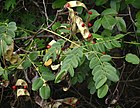Note: This is a project under development. The articles on this wiki are just being initiated and broadly incomplete. You can Help creating new pages.
Difference between revisions of "Adenanthera pavonina - Ksharaka"
(→Identification) |
|||
| Line 38: | Line 38: | ||
===Flower=== | ===Flower=== | ||
| − | {{Flower|Bisexual|Axillary spiciform racemes|Pale yellow|10|Flowering | + | {{Flower|Bisexual|Axillary spiciform racemes|Pale yellow|10|Flowering from January to May}} |
===Fruit=== | ===Fruit=== | ||
| − | {{Fruit|A Pod|10-25 x 0.7-1.5 cm|Follicle 2-angled, acute, straight to falcate to slightly twisted, spirally coiled after dehiscence|Seeds 6-15|}} | + | {{Fruit|A Pod|10-25 x 0.7-1.5 cm|Follicle 2-angled, acute, straight to falcate to slightly twisted, spirally coiled after dehiscence|Seeds 6-15|Fruiting from January to May}} |
===Other features=== | ===Other features=== | ||
Revision as of 11:56, 8 December 2021
Ksharaka is a fast-growing deciduous tree with a spreading crown of light, feathery foliage. The tree is widely cultivated in the tropics for a wide range of uses. A very ornamental plant with fragrant, creamy flowers, it is often grown as a specimen and as a street tree.
Contents
- 1 Uses
- 2 Parts Used
- 3 Chemical Composition
- 4 Common names
- 5 Properties
- 6 Habit
- 7 Identification
- 8 List of Ayurvedic medicine in which the herb is used
- 9 Where to get the saplings
- 10 Mode of Propagation
- 11 How to plant/cultivate
- 12 Commonly seen growing in areas
- 13 Photo Gallery
- 14 References
- 15 External Links
Uses
Arthritis, Burning sensation, Vomiting, Fever, Hemorrhoids[1]
Parts Used
Bark, Leaves, Heartwood, Seeds
Chemical Composition
The seed contains an anti-inflammatory active principle, O-acetylethanolamine. The leaves contain octacosanol, dulcitol, glucosides of betasitosterol and stigmasterol. The bark contains sitgmasterol glucoside.[2]
Common names
| Language | Common name |
|---|---|
| Kannada | Aane gulaganji |
| Hindi | Baragunci, Barighumchi |
| Malayalam | Manjadi |
| Tamil | Aanaikundrimani, Anaikundumani |
| Telugu | Bandi gurivenda, Bandi gurvina |
| Marathi | NA |
| Gujarathi | NA |
| Punjabi | NA |
| Kashmiri | NA |
| Sanskrit | Kamboji, Ksharaka |
| English | Coralwood tree |
Properties
Reference: Dravya - Substance, Rasa - Taste, Guna - Qualities, Veerya - Potency, Vipaka - Post-digesion effect, Karma - Pharmacological activity, Prabhava - Therepeutics.
Dravya
Rasa
Tikta (Bitter)
Guna
Laghu (Light)
Veerya
Sheeta (cold)
Vipaka
Karma
Pitta
Prabhava
Habit
Identification
Leaf
| Kind | Shape | Feature |
|---|---|---|
| Bipinnate | Alternate | Leaves bipinnate, alternate, stipulate, rachis 14.5-62.5 cm long, stout, with a gland at the tip. |
Flower
| Type | Size | Color and composition | Stamen | More information |
|---|---|---|---|---|
| Bisexual | Axillary spiciform racemes | Pale yellow | 10 | Flowering from January to May |
Fruit
| Type | Size | Mass | Appearance | Seeds | More information |
|---|---|---|---|---|---|
| A Pod | 10-25 x 0.7-1.5 cm | Follicle 2-angled, acute, straight to falcate to slightly twisted, spirally coiled after dehiscence | Seeds 6-15 | Fruiting from January to May | {{{6}}} |
Other features
List of Ayurvedic medicine in which the herb is used
Where to get the saplings
Mode of Propagation
How to plant/cultivate
The seed coats are extremely hard and requires scarification. It can be physically removed by rubbing against a rough surface such as sand paper or by soaking in warm water for 24 hours. They can then be sowed in polybags or nursery beds.[5]
Commonly seen growing in areas
Photo Gallery
References
External Links
- Ayurvedic Herbs known to be helpful to treat Arthritis
- Ayurvedic Herbs known to be helpful to treat Burning sensation
- Ayurvedic Herbs known to be helpful to treat Vomiting
- Ayurvedic Herbs known to be helpful to treat Fever
- Ayurvedic Herbs known to be helpful to treat Hemorrhoids
- Herbs with Bark used in medicine
- Herbs with Leaves used in medicine
- Herbs with Heartwood used in medicine
- Herbs with Seeds used in medicine
- Herbs with common name in Kannada
- Herbs with common name in Hindi
- Herbs with common name in Malayalam
- Herbs with common name in Tamil
- Herbs with common name in Telugu
- Herbs with common name in Sanskrit
- Herbs with common name in English
- Habit - Tree
- Index of Plants which can be propagated by Seeds
- Index of Plants which can be propagated by Cuttings
- Herbs that are commonly seen in the region of Tropical area
- Herbs
- Plants of western ghats
- Fabaceae




